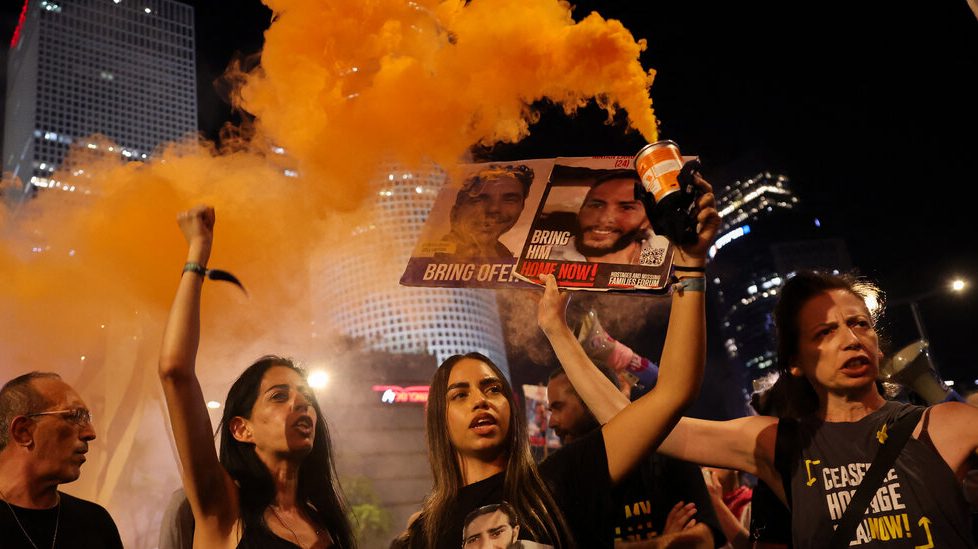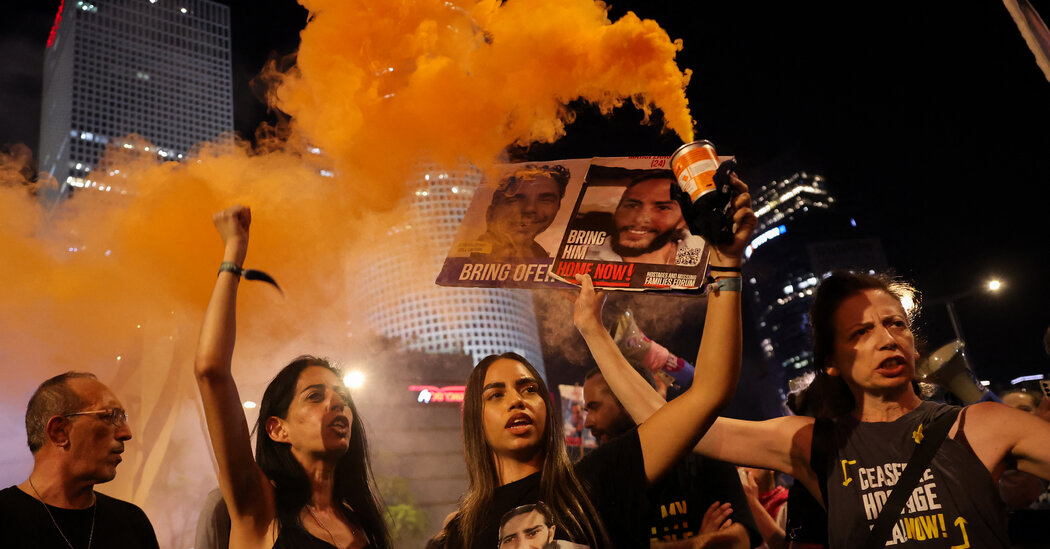Hamas’s Release of Hostage Videos Inflames Divisions in Israel


Late on Thursday night in Israel, shortly after thousands of protesters marched with coffins to the military’s headquarters in Tel Aviv demanding a deal for the return of hostages in Gaza, Hamas released a video of one of the captives, Hersh Goldberg-Polin, 23, recorded at some point before he was killed.
It was the fourth such recording released by Hamas in as many days, a piecemeal torment for Israelis that appeared designed to inflame the country’s divisions and increase pressure on Prime Minister Benjamin Netanyahu. The videos have shown, still living, five of the six hostages whose bodies the Israeli military retrieved from Gaza last weekend — images that starkly underscored what is at stake for the roughly 60 surviving captives if there is no deal.
“This must serve as an immediate wake-up call to the world to take action today,” Mr. Goldberg-Polin’s parents, Jon Polin and Rachel Goldberg-Polin, said in a statement after the video of their son was released. It was unclear when the footage was taken.
Mr. Netanyahu has remained adamant that he will not agree to terms he believes would allow Hamas to regroup in Gaza, even as protests demanding a deal with Hamas have been held in Israel daily since Sunday, when the military announced the recovery of the bodies of Mr. Goldberg-Polin and five other hostages. The Israeli Ministry of Health said that autopsy reports showed all six had been shot at close range shortly before soldiers found their bodies.
The parents of Mr. Goldberg-Polin, an Israeli American, have been vocal advocates for a cease-fire deal and called urgently for an end to the war in Gaza at the Democratic National Convention in August. Their son also appeared in a video that Hamas released in April.
“No other family should go through what our family (and the families of the other recently executed hostages) have endured,” the couple said in their statement on Thursday.
Rights groups and international law experts say that a hostage video is, by definition, made under duress, and the statements in it are usually coerced. Israeli officials have called the videos a form of “psychological warfare,” and experts say their production can constitute a war crime.
The obstacles to a cease-fire agreement have not been resolved, with Israel and Hamas blaming each other for the impasse in talks.
“There’s not a deal in the making,” Mr. Netanyahu told Fox News in an interview released on Thursday. The Israeli leader continued to reject the contention that the primary stumbling block was his insistence on maintaining an Israeli troop presence in a strip of Gaza bordering Egypt called the Philadelphi Corridor, though he argued it was key to Israel’s security.
Hamas, for its part, has lost many of its fighters and leaders over the 11 months of the war, and the Gaza Strip, which it used to rule, has been devastated.
But the group is still holding out for a deal on its terms. A member of Hamas’s political bureau, Dr. Khalil al-Hayya, said in a statement on Thursday that any cease-fire agreement must include Israel’s “complete withdrawal from the Gaza Strip” and demanded that mediators compel Israel to retreat from its latest conditions.
The Biden administration has said it believes a deal can still be reached. White House spokesman John Kirby conceded on Thursday that “there’s no formal negotiation going on at this time,” but said communication among Israel, Hamas and mediators continued.
Israel and Hamas are also at odds over arrangements for an exchange of prisoners for the hostages in Gaza, including the bodies of 35 who are believed to be dead. Hamas had agreed to the proposal months ago but recently added new demands for the release of hostages, asking for more Palestinian prisoners to be released in the opening phase of any agreement, two American officials said.
The killings of the six hostages has further complicated the issue: “There’s now fewer names on the list” of captives to be exchanged, the U.S. official said. And Hamas has suggested it may execute more hostages should Israeli forces get too close to where they are being held.
Relatives of the hostages are all too aware of this. On Friday, they will usher in Shabbat by lighting candles at what is now known as Hostages Square in Tel Aviv, the Hostages and Missing Families Forum said. On Saturday evening, “following a particularly tumultuous and sad week,” they will gather again, the forum said, urging Israelis to rally with them “en masse and demand a deal.”
The post Hamas’s Release of Hostage Videos Inflames Divisions in Israel appeared first on New York Times.
